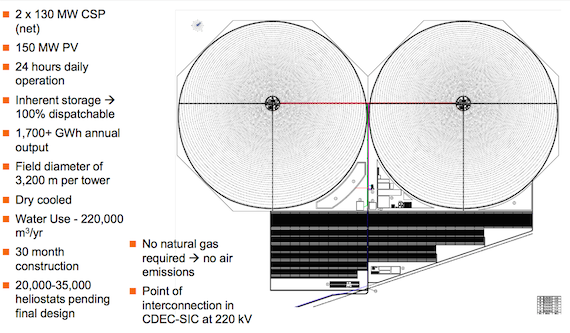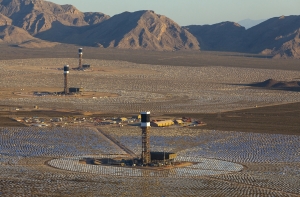As pointed out in this article, some environmentalists and clean energy advocates remain skeptical that a nuclear-free, carbon-free energy system is attainable; and we’ve had a few strong and interesting responses to my recent post The archaic nature of baseload power–or why electricity will become like long-distance. In that article, I laid out the obsolete nature of the 20th century electricity system, which relied on large “baseload” nuclear and fossil fuel plants located far from the largest electricity consumers sending (and wasting) electricity over long high-voltage transmission lines. Such a system simply makes no sense anymore given the cheaper, cleaner, generally smaller-scale, and more sustainable energy technologies of the 21st century. But there is a kind of “baseload” power that does make some sense. And that’s the kind that doesn’t involve nuclear or fossil fuels.
It can be argued, of course, that any system that provides electricity 24/7 is “baseload” power–and I would make that argument. Thus, a rooftop solar system with good battery backup is, by that definition, baseload power.
But what I neglected somewhat in the original piece was that renewables are increasingly capable of providing large-scale “baseload” power as well. Spain has a 24-7 baseload solar plant, for example, although it has not yet been a stunning economic success. And now Chile has just given the ok for a new 260 megawatt solar plant–using a combination of photovoltaic and concentrating solar power technology–that promises to provide 24/7 baseload power. For 10 cents kw/h. That’s cheaper than any new nuclear power and most existing nuclear power. With no government subsidies whatsoever.
Yes, the system is not perfect: it does still require those long transmission lines. And yes, you can’t build these things everywhere–although you could build an awful lot of them on essentially unused land in the southwest U.S.–think Nevada, Arizona, New Mexico–and provide an awful lot of power to a lot of places. It’s been estimated that you could power the entire U.S. on solar power built on 10,000 square miles of unused Nevada land. Of course, back in the late 1980s, the Department of Energy figured out you could power the entire country on wind power from South Dakota. And some in Europe have envisioned powering the entire continent with solar power located in the Saharan Desert.
Great in theory, perhaps not so perfect in practice.
Meanwhile, wind power is edging ever closer to “baseload” status. New technology, and the ability to build taller windmills with longer blades, already has brought wind to 50% capacity factors in the Midwest and west Texas, and the industry believes it will regularly be reaching 60-65% capacity factors in just a few years. At that level, wind’s capacity factor starts to be very competitive with fossil fuels. And right now, wind is averaging less than 3 cents kilowatt/hour.
Nuclear typically reaches even higher capacity factors: 85-95% and sometimes more–when reactors are operating. But they have to be taken down and refueled every 12-18 months, a job that normally requires a few weeks (and requires a huge amount of backup power to be available when they do shutdown–as does their mere existence, in the event of a sudden shutdown or other problems). And, as Dr. Ian Fairlie pointed out here recently, when refueling occurs, large amounts of radiation are released–one of the key reasons for higher leukemia rates around reactors. Most people would probably trade less leukemia for a somewhat lower capacity factor.
Geothermal, where it works, and hydropower, are also “baseload” renewable energy sources. Recently Norway, which obtains most of its power from hydro, offered to serve as the “green battery” backup system for Europe’s growing renewable-powered grid.
The point is this: the overriding need for an electricity system is reliability. Electricity has to be available when it’s needed, in the quantity needed, and that has to be done instantaneously. Changing how much is needed and when it’s needed is the demand side of the issue–that’s where energy efficiency–everything from LED lightbulbs, to simple insulation, to smart thermostats and smart homes–and concepts like Rocky Mountain Institute’s “flexiwatts” come in.
On the generation and distribution side of the equation, it doesn’t really matter whether you call it “baseload” or not–as long as it meets the fundamental requirement of clean electricity being there when needed. The 21st century electricity system does not need the traditional large nuclear and fossil fuel plants, period; just as our planet does not need or want their carbon dioxide and radioactive waste. Solar facilities running 24/7–sure! Wind power generating most of the time–yep! Existing hydro and some geothermal serving as backup? Why not? And a grid that can ramp up and down and switch from solar to wind and back again depending on what is generating how much where. Absolutely. We’ll still have big power lines, of course–they’re not disappearing from the landscape anytime soon. But we’ll have more generators closer to where they’re needed, and a more dispersed generation system reliant on many different generators and types of generation rather than a few very large killer power plants means a more secure generating system. A hurricane (or perhaps even a hacker) can knock out a few large power plants and/or their transmission lines and electricity service is disrupted for days, even weeks. That is far less of a threat with a distributed generating system. The 21st century system will prove even more reliable.
The advances in clean energy are occurring so fast these days that they’re nearly outpacing our ability to comprehend just how far we’ve already come. The best part is that we’re not even close to how far we’re going to go.
Michael Mariotte
August 26, 2015
Permalink: http://safeenergy.org/2015/08/26/renewables-as-baseload-power/







